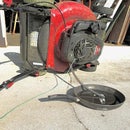Introduction: Spanner Wrench for Whirlpool or Kenmore Washer Tub Nut
You may need to remove the tub from your Whirlpool or Sears Kenmore washing machine for some repairs. You will need a special spanner wrench. They can be ordered for about $14 US plus shipping. I needed one immediately and decided to make my own. The photo shows the tub nut on the drive block. Both are shown removed from our direct drive washing machine. The nut is inside the tub and under the agitator. Space is limited by the sides of the tub to about ten inches between the nut and the side of the tub. The nut is also a few inches below the top of the tub. It is difficult to access with anything but a spanner wrench designed for the job.
Step 1: Materials
The key part in my spanner wrench will be a scrap piece of steel pipe nearly the same diameter as the tub nut. A couple of inches in length is sufficient. My scrap piece was about eight inches long and I chose to leave it uncut in case I want to use it for something else in the future.
Step 2: Wrap With Masking Tape
There is some marking to be done. Wrap the end of the pipe with masking tape to make it easy.
Step 3: Mark Around the Circumference
Mark around the circumference of the pipe with a line set off from the end of the pipe a distance equal to the thickness of the nut.
Step 4: Mark the Pipe for the Nut Indentations
Make four marks on the masking tape that correspond to the recessed or indented portions of the nut.
Step 5: Make Vertical Cuts
With a cutting wheel in an angle head grinder make a vertical cut on each side of the marks for the indentations in the nut. It is better to leave the cuts a little wide rather than too close together. You are cutting away material that will leave four teeth to fit into the indentations in the nut. If the teeth are a little wide, you can grind on each later for a near perfect fit on the nut.
Step 6: Cut for Removing Excess
I turned the pipe in my vise to make a cut along the circumference line in step 3 that goes up to the vertical cuts made in step 5, but does not cut into the four teeth.
Step 7: Break Surplus Material Away
The pipe material between the teeth has been partially, but not fully, cut away. The round wheel on the angle head grinder cannot cut deeply enough without cutting away to much of the teeth. Grasp the portions to be removed with a locking pliers and twist up and down. It will break away very easily. Any waste material still part of the pipe can be ground away with the cutting wheel. Remove the excess portions between all four teeth.
Step 8: Refine the Fit
I found the inner diameter of the pipe was a bit smaller than the diameter of the nut at the inner part of the indentations. I used my grinder to grind the inside face of each tooth. This made the teeth thinner, but not enough to compromise the usefulness of the wrench.
Step 9: Final Fit
Grind lightly on the sides of one tooth until it slides easily onto the nut. Visually examine what might need to be ground from the next tooth for it to fit, too. Check the other two teeth to be certain your grinding will not have removed material that will cause either of those teeth not to fit when it comes time to grind them for the correct width. When finished, the wrench should fit nicely over the nut with the four teeth fitting neatly into the indentations on the nut.
Step 10: Weld an Arm to the Pipe
The spanner wrench is usually struck with a hammer. For that, an arm needs to be welded to the pipe. I had a piece of 1/4 x 1 1/2 inch steel bar about 6 inches long. I ground one end to fit the contour of the pipe's surface. I clamped it in my vise and set the pipe on something to hold the pipe in the right position for welding.
In the absence of welding capabilities, a long pipe wrench could be used on a wrench made from a longer piece of pipe.
In the photo you can see the teeth on the wrench quite clearly.
In the absence of welding capabilities, a long pipe wrench could be used on a wrench made from a longer piece of pipe.
In the photo you can see the teeth on the wrench quite clearly.
Step 11: Using the Wrench
To use the wrench, engage the teeth in the indentations in the nut. Here the tub nut and the drive block are positioned in my vise very much as they would be in the washing machine tub. Strike the arm welded to the pipe with a hammer. The nut is right-hand thread, so strike to make the nut turn counter-clockwise. The nut on my washer loosened almost immediately, even though I had tried several other strategies before with no success.











